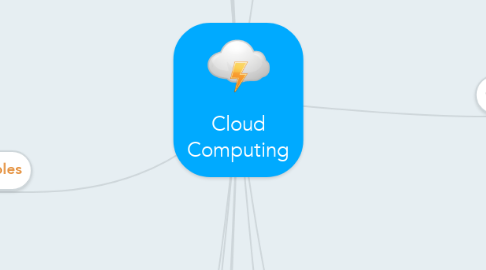
1. Cloud Applications
1.1. Energy
1.2. Manufacturing
1.3. Mobile Communications
1.4. Education
1.5. Government
1.6. Transport
2. Cloud Security Concerns
2.1. Privacy Issues
2.2. Security
3. Cloud Based Projects
3.1. http://iplt20-prediction.appspot.com
3.2. http://arg.ap01.aws.af.cm/web
3.3. http://resume-2-mindmap.appspot.com/
3.4. http://7.self-learning.appspot.com
3.5. http://www.markmelive.com
4. Evolution till Cloud Computing
4.1. Computing enters world (1960)
4.1.1. Computing came to business world.
4.2. Mainframe Computing
4.2.1. Advantages
4.2.1.1. Helped business to carry out some mundane and routine jobs such as payroll, account, inventory thus sparing employees from tedious jobs.
4.2.2. Dis-Advantages
4.2.2.1. Centralized model of computing. Anyone who wants computing must go to the computer center for availing it.
4.3. Personal Computing (1980)
4.4. Client Server Computing
4.5. Cluster Computing
4.6. Grid Computing
4.7. Web 2.0 Business Models
4.8. Cloud Computing (Today)
4.9. Mobile Cloud Computing
5. Cloud Examples
5.1. IBM BlueMix
5.2. Google App Engine
5.3. Amazon Web Services
5.4. Meghraj
6. Many Definitions
6.1. Teachers
6.1.1. Survival Tool
6.2. Students
6.2.1. Tool of Tomorrow
6.3. Everybody
6.3.1. New Writing Slate
6.3.2. New Learning Habitat
6.3.3. New Phenomenon
6.3.4. Upholding Values
6.3.5. Sharing useful thoughts
6.3.6. Liberating Technology
6.3.7. Democratic Technology
6.4. Opportunity
6.4.1. Start-Ups
6.4.2. Enterpreneurs
6.4.3. Students
6.4.4. Freelancers
7. Essential Characteristics
7.1. On Demand Self-Service
7.2. Ubiqitous Network Access
7.3. Rapid Elasticity
7.4. Location Independent Resource Pooling
7.5. Measured Service
8. Cloud Computing/for Whom ?
8.1. Medical Field
8.2. Parents
8.3. National Purposes
8.4. Cloud Cricket
8.5. Cloud Election
8.6. Cloud Movie
8.7. Government
9. Foundational Elements
9.1. Virtualization
9.1.1. Hypervisors
9.1.1.1. Types
9.2. Distributed Computing
9.3. Autonomic Systems
9.4. Grid Technology
9.5. Broadband Networks
9.6. Web 2.0
9.7. Service Oriented Architecture
9.8. Free and Open Source Software
9.9. Web Application Frameworks
9.10. Browser as a Platform
9.11. Service Level Agreements
9.12. Utility Computing
10. Key Terms
10.1. Service
10.2. Service Delivery
10.3. Network
10.4. Cloud Computing
10.5. SOA
10.6. Security
10.7. Privacy
10.8. Clinet
10.9. Ubility
10.10. Data Center
10.11. Cloud Service
10.12. Service Models
10.13. Cluster Computing
10.14. Cloud Storage
10.15. Cloud Application
10.16. Cloud Database
10.17. Cloud Operating System
10.18. Cloud Consumer
10.19. Cloud Broker
10.20. Cloud Auditor
10.21. Cloud Carrier
10.22. Cloud Engineering
10.23. Virtualization
10.24. Grid Computing
11. Cloud Stake Holders
11.1. Cloud Consumer
11.1.1. User
11.2. Cloud Auditor
11.2.1. Security Audit
11.2.2. Privacy Impact Audit
11.2.3. Performance Audit
11.3. Cloud Provider
11.3.1. Service Layer
11.3.1.1. SaaS
11.3.1.2. PaaS
11.3.1.3. IaaS
11.3.2. Physical Resource Layer
11.3.2.1. Hardware
11.3.2.2. Facility
11.3.3. Resource Abstraction & Control Layer
11.3.4. Cloud Service Management
11.3.4.1. Business Support
11.3.4.2. Provisioning / Configuration
11.3.4.3. Portability/Interoperability
11.4. Cloud Broker
11.4.1. Service Intermediation
11.4.2. Service Aggregation
11.4.3. Service Arbitrage
11.5. Cloud Carrier
12. Deployment Models
12.1. Private
12.2. Public
12.3. Hybrid
12.4. Community
13. Cloud Service Delivery Models
13.1. SaaS
13.1.1. Meaning
13.1.2. Characteristics
13.1.3. Limitations
13.2. PaaS
13.2.1. Meaning
13.2.2. Characteristics
13.2.3. Limitations
13.3. IaaS
13.3.1. Meaning
13.3.2. Characteristics
13.3.3. Limitations
13.4. .....
13.5. XaaS
13.5.1. Here anything is available as a service over the browser
